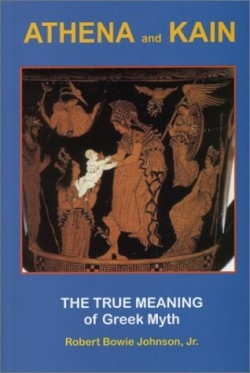Athena and Kain
“The Greek myths tell the same story as the early chapters of the Book of Genesis,” posits the author, “except from the point of view that the serpent is the enlightener of mankind rather than its deceiver.” Zeus and Hera, Johnson further suggests, are the Greek mythological versions of Adam and Eve in the Garden of Eden. The parallels are striking between the stories in the Bible and those appearing in all manner of Greek life, including those depictions on the Parthenon. For example, the theme of the east pediment of the Parthenon is Athena’s rebirth after the Flood, as discussed in Johnson’s previous book, Athena and Eden: The Hidden Meaning of the Parthenon’s East Façade.
Going beyond mere assertions in offering this thesis, Johnson, an educator, Greek art interpreter, Parthenon iconographer, and public speaker, meticulously demonstrates its viability by studying the parallels between Judeo-Christian art and Greek artifacts. For instance, a painting by Tintoretto from circa 1550 CE, portraying Eve sharing her “enlightenment” with Adam, corresponds to the same scene on a vase, circa 475 BCE, as Hera shares her enlightenment with Zeus. Says Johnson: “From the Judeo-Christian standpoint, the taking of the fruit by Eve … was shameful, a transgression. … From the Greek standpoint, however, the taking of the fruit (by Hera) was a triumphant … act which brought to mankind the serpent’s enlightenment.”
The two stories coincide further in that both Hera and Eve are cast from a Garden. In the Bible, it’s Eden. In Greek mythology, it is the Garden of the Hesperides, which is always depicted in Greek art with a serpent-entwined fruit tree.
Many examples of the parallel myths from both the Bible and Greek mythology follow throughout this book. Some will cause eyebrows to go up with surprise. The book is easy to read-almost “light” reading. It is both entertaining and informative and would be suitable reading for scholars as well as those casually interested in mythology.
Disclosure: This article is not an endorsement, but a review. The publisher of this book provided free copies of the book to have their book reviewed by a professional reviewer. No fee was paid by the publisher for this review. Foreword Reviews only recommends books that we love. Foreword Magazine, Inc. is disclosing this in accordance with the Federal Trade Commission’s 16 CFR, Part 255.

